Relatives
Mespilus germanica L. - Medlar.
Taxonomic position.
Family Rosaceae Juss., genus Mespilus L.Synonyms.
Mespilus sylvestris Mill., M. communis Gueldenst., M. vulgaris Reichenb., Crataegus mespilus O. Katze, Pyrus germanica Hook. f.Morphology and biology.
Thorny deciduous shrub or tree, 1.5-5 m tall, with gray branches. Young shoots are red-brown, downy. Leaves are 5-12 cm long, elliptical or oblong-lanceolate, acute or obtuse at the top, smooth-edged or dentate, with denticles carrying a red glandule on the tip, dark green, covered with sparse hairs above, light-colored, whitish and downy below, with longer and denser pubescence along the main veins. Young leaves are downy on both sides. Petioles are shaggily pubescent. Flowers are solitary, large, 3-5 cm in diameter, white, almost sessile. Sepals are lanceolate, awl-shaped, longer than the petals. Fruits are 1.5-2.5 cm in diameter, ranging in shape from depressed globular to pear-shaped, brownish and almost bare. Entomophilous. Zoochore. Blossoms in April-May; bears fruit in October-November. 2n=32.Distribution.
Occurs in the Crimea (south), the Caucasus, Middle Asia (Kopetdagh: the ravine of Gyuyen on Chandyr River, the vicinity of Koyna-Kosyr Village in the valley of Sumbar River), Europe (Bulgaria and Greece), Turkey, Iran and Iraq.Ecology.
Mesophyte. Photophilous. Grows as solitary plants or as part of shrubby thickets on open mountainsides, along forest edgesm in the underbrush of oak and oak-hornbeam groves, frequently in carbonate soils, as well as transported sandy soils along the beach ridges of the Caspian Sea. Medlar grows mainly in the lower mountain zone (at elevations of 800-1,000 m above sea level in the Caucasus and 300-600 m in the Crimea) but is able to grow up to 1,800 m above sea level, while in Talysh, it nearly reaches the tree line.Utilization and economic value.
Used as food and as an ornamental plant. Fruit are widely used by local populations to prepare thickened jam, sweet paste, candy filling and drinks. Used as a seedling stock for loquat.Reference citations:
Brezhnev D.D., Korovina O.N. 1981. Wild relatives of cultivated plants in the flora of the USSR. Leningrad: Kolos. 304 pp. (In Russian)Poyarkova A.I. 1939. Medlar-Mespilus L. Flora of the USSR. Vol. 9. Moscow-Leningrad: Publishing House of the USSR Academy of Sciences. 414-416 pp. (In Russian)
Sokolov S.I., Svjaseva O.A., Kubli V.A. 1980. Areas of distribution of trees and shrubs in the USSR. Vol. 2. Leningrad: Nauka. 67 pp. (In Russian)


